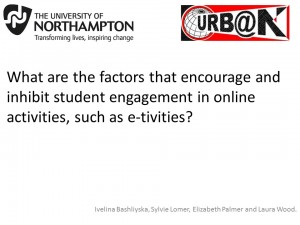Ivelina Bashliyska, Sylvie Lomer, Elizabeth Palmer and Laura Wood
Download slides: PDF / Powerpoint
The Centre for Achievement and Performance (CfAP) offers a range of transferable cognitive and academic skills development opportunities for students, through both face-to-face and online delivery. CfAP is in the process of modifying its delivery in order to offer scalable opportunities for personalised, independent online learning and to maximize the impact of our face to face time with students, using blended learning as part of their workshop delivery. Workshops delivered are embedded in subject courses and modules, on request from lecturers and module leaders. Much research has been done into what makes a ‘good’ e-tivity: clear instructions and design, purposeful, perceived relevance, practice opportunities, interactive, structured pathways and sequencing, effective feedback and interactions with the tutor (Swan, 2001; Sims et al., 2002; Lim et al., 2007; Salmon, 2013; Clark & Mayer, 2011; University of Leicester, n.d.) However, even when following such principles, student engagement with CfAP designed e-tivities has varied markedly. This research project adopted qualitative methodologies involving students as co-researchers in two stages in order to uncover the causes and factors underpinning this variation. In the first stage, the student researchers deductively analysed the blended learning activities to establish whether, from a student perspective, they conform to good design principles (Clark & Mayer, 2011; Salmon; 2013). In the second stage, focus groups were conducted with staff and students involved in some of the blended learning activities at UoN. This paper will discuss the complexity of the causes and factors that are affecting student engagement.
Clark, R. C., & Mayer, R. E. (2012). Scenario-based e-learning: Evidence-based guidelines for online workforce learning. John Wiley & Sons.
Lim, D. H., Morris, M. L., & Yoon, S. W. (2006). Combined effect of instructional and learner variables on course outcomes within an online learning environment. Journal of Interactive Online Learning, 5(3), 255-269.
Salmon, G. (2013). E-tivities: The key to active online learning. Abingdon: Routledge.
Sims, R., Dobbs, G., & Hand, T. (2002). Enhancing quality in online learning: Scaffolding planning and design through proactive evaluation. Distance Education, 23(2), 135-148.
Swan, K. (2001). Virtual interaction: Design factors affecting student satisfaction and perceived learning in asynchronous online courses. Distance education, 22(2), 306-331.
University of Leicester (n.d.) Develop your e-tivities: e-tivity rubric. University of Leicester [online] Available at: http://www2.le.ac.uk/projects/oer/oers/beyond-distance-research-alliance/7Cs-toolkit/archived-7cs-resources/e-tivity-development-resources [Accessed on 10 November, 2015].

